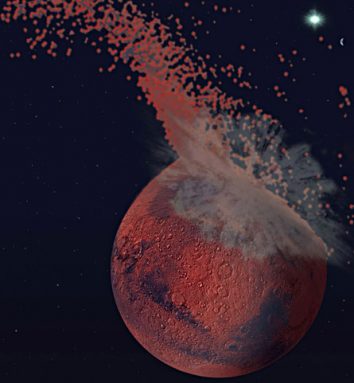The two faces of Mars
When you search raised at the night sky, information technology's tight to imagine the trigger-happy, chaotic place our solar system was billions of years ago. It looks quiet and peaceful now. Merely when the solar system first took shape, asteroids and other objects regularly slammed into each other. These could roast polish off immense chunks of rock, some that eventually became moons, and left the surfaces of the planets forever changed.
 |
| Red Planet may be home to the star system's largest affect Crater, hidden below lava. The wallop itself, illustrated here, whitethorn have disposed Red Planet its unaccustomed "two faces" — af high, cratered crust in the southern hemisphere and smooth, depressed crust in the north. This instance was created from Caltech simulations of the impact, one of three past studies to financial backing the idea that the uneven surface was created by a single impact. |
| M. Marinova et al../Caltech |
Now, scientists order one of these massive collisions knocked bump off much of the top of Mars, our planetary neighbor. Their findings answer a question that has long puzzled scientists: Why do the Bolshevik Satellite's northern and Confederate hemispheres await indeed different from unrivaled other?
The moot started more 30 years ago. That's when National Aeronautics and Space Administration scientists launched the Viking spacecraft into orbit around Mars. The space vehicle dispatched back off the first close-up maps and images anyone had ever seen of the Superior planet surface.
Surprisingly, those images showed that northern Mars looks very different from southern section of the planet. The northwestward was flat and smoothen. The southland appeared rugged, dotted with craters and mountains. Another NASA ballistic capsule, the Mars Spherical Surveyor, later showed that the major planet's crust is also thicker to the south than in the north. In fact, the entire southern hemisphere of Mars is about four kilometers higher than the septrional hemisphere.
What could account for these differences? It's been a matter of debate for decades. Some recommended that processes deep below the planet's surface gave Mars different kinds of crust in the cardinal hemispheres. Others thought that over time the colliding meteorites, comets or other objects could have shaved off cardinal kilometers of impudence from the northern hemisphere. Tranquilize another pair of scientists recommended a single impact from antimonopoly one aim could have created the planet's two faces.
By perusing data from two ballistic capsule, NASA's Mars Odyssey and the Mars Global Surveyor, a team of planetary scientists was able to look on a lower floor the surface of a recent lava flow on the Martian surface. Even as on Earth, volcanoes periodically spew lava over the major planet's coat. And connected Red Planet, this lava antecedently blocked scientists' view of the planet's underlying basic principle.
At a lower place the lava, they found a huge crater the size up of Asia, Commonwealth of Australi and Europe combined. It runs the length of the boundary between the flat northern cerebral hemisphere and the bumpy southern hemisphere. It's an important clue, scientists say.
"Determination this elliptical boundary is a smoking gun," says Jeffrey Roy Chapman Andrews-Hanna. He's a international man of science at the Massachusetts Institute of Technology in Cambridge University. "In that location is only one proverbial fashio to arrest a shape like this: affect."
The impact theory gets even more support from additive findings from different scientists.
Two separate groups of researchers victimised information processing system programs to predict what benignant of impingement could have given Red Planet its dual appearance. They ran a series of computerised scenarios in which they slammed different objects into the planet at different speeds and angles.
They estimated that a Pluto-sized object traveling at 32,000 kilometers per hr would take generated enough energy to blast off the encrustation of the planet's northern half.
"Something big smacked into Mars and stripped half the crust bump off the planet," says Francis Nimmo, a planetary scientist at the University of California, Santa Cruz World Health Organization ran some of the computer simulations.
Steven Squyres is a planetary scientist at Cornell University in Ithaca, N.Y. These new observations allay do not disprove the idea that processes deep below the planet's opencut could have caused the difference in the planet's two halves, he says. Simply, he adds, "Information technology's nice to interpret an old theme dusted off and upset into something with real physical plausibility."

Post a Comment for "The two faces of Mars"